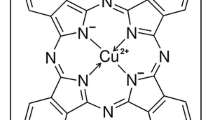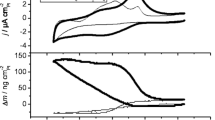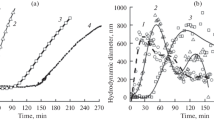Abstract
The electrochemical quartz crystal microbalance (EQCM) was applied to study the electrochemical behaviors of polycrystalline Au in sulfuric acid solution. The large mass change observed in the doublelayer region was attributed to the partly discharged adsorption of sulfate anions with the co-adsorption of H2O. According to the observed EQCM frequency response, the formation mechanism of surface oxide was reasonably postulated, in which the roles of the adsorbed anions and the co-adsorbed H2O were particularly emphasized.
Similar content being viewed by others
References
Angerstein-Kozlowska H, Conway BE, Burneerr B,et al. The role of ion adsorption in surface oxide formation and reduction at noble metals.J Electroanal Chem, 1979,100(1):417–446
Angerstein-Kozlowska H, Conway B E, Hamelin A,et al. Elementary steps of electrochemical oxidation of single-crystal plane of Au: Part II.J Electroanal Chem, 1987,228(1):429–453.
Burke L D, Lee BH. An investigation of the electrocatalytic behavior of gold in aquous media.J Electroanal Chem, 1992,330(1–2):637–661
Burke LD, O'Sullivan JF. A study of the electrocatalytic behavior of gold in acid using ac voltammetry.Electrochim Acta, 1992,37(11):2087–2094
Bruckenstein S, Shay M. An in situ weighting study of the mechanism for the oxide formation at a gold electrode.J Electroanal Chem, 1985,188(1):131–136
Bruckenstein S, Shay M. Experimental aspects of the quartz crystal microbalance in solution.Electrochim Acta, 1985,30(10):1293–1300
Gordon J S, Johnson D C. Application of an electrochemical quartz crystal microbalance to a study of water adsorption at gold surfaces in acidic media.J Electroanal Chem, 1994,365(1–2):267–274
Wu BL, Lei HW, Cha CS. Time-resolved quartz crystal microbalance.J Electroanal Chem, 1994,374(1–2):97–99
Chen SL, Wu BL, Cha CS. The time-resolved EQCM and study of the kinetics of the silver oxide formation on a polycrystalline silver electrode in alkaline solution.J Electroanal Chem, 1997,420(1–2):111–118
Uchida H, Ikeda N, Watanaba M J. Electrochemical quartz crystal microbalance study of cooper adatoms on gold electrode: Part II.J Electroanal Chem, 1997,424 (1–2):5–12
Tilak BVH, Angerstein-Kozlowska H, Conway B E. Real conditions of oxidation Pt electrode: Part III.J Electroanal Chem, 1973,48(1):1–23
Author information
Authors and Affiliations
Additional information
Supported by the National Natural Science Foundation of China
Chen Shengli: born in 1968, Ph. D.
Rights and permissions
About this article
Cite this article
Shengli, C., Bingliang, W. & Hong, Z. An EQCM study of the electrochemical behaviors of polycrystalline gold electrode in sulfuric acid solution. Wuhan Univ. J. Nat. Sci. 3, 102–107 (1998). https://doi.org/10.1007/BF02827526
Received:
Issue Date:
DOI: https://doi.org/10.1007/BF02827526




